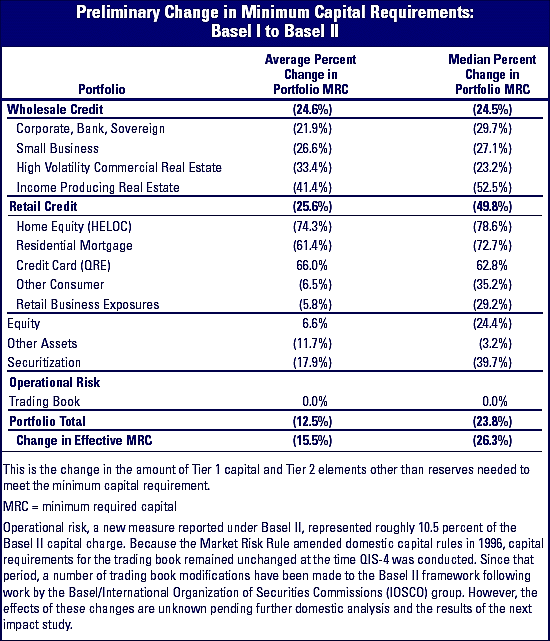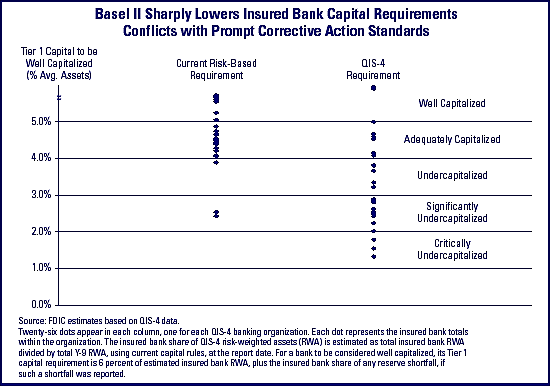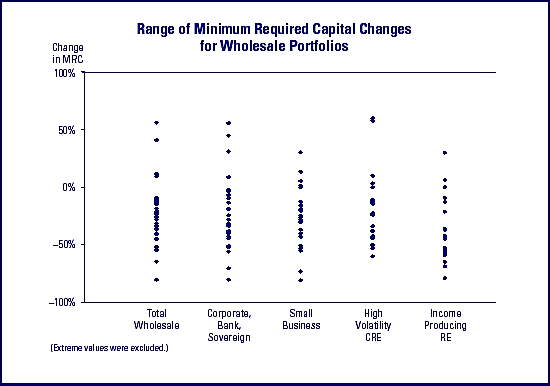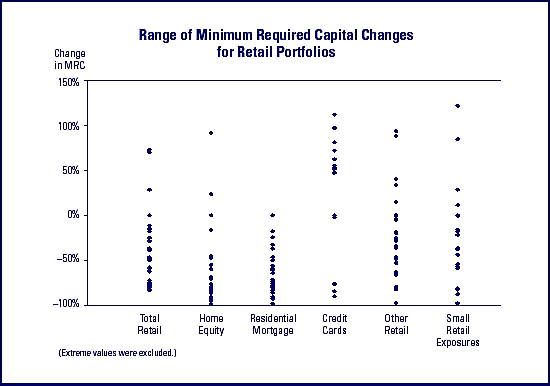This regular feature focuses on topics of critical importance to the bank accounting function. Comments on this column and suggestions for future columns can be e-mailed to SupervisoryJournal@fdic.gov.
The Basel II Capital Accord represents a major shift in international capital policy. As Europe moves rapidly ahead with its legislative process to adopt Basel II, attention has focused on U.S. implementation. Some commentators have criticized the U.S. Basel II implementation process for being both slower in pace and more conservative in its approach to required capital than the approach taken across the Atlantic. This article reviews some of the highlights of the U.S. banking agencies' recent capital impact study to provide some context to the agencies' recently announced implementation plans.
On September 30, 2005, the U.S. agencies announced a revised timeline for moving ahead with the implementation of Basel II in the United States.1 The revised plan includes more time to implement the framework and floors on banks' risk-based capital requirements during a three-year transitional period. The revised plan was driven in substantial part by the results of the agencies' recent Quantitative Impact Study (QIS-4). Specifically, at present the Basel II framework appears likely to recommend capital levels that may not be sufficient to address the risks banks face. It also appears likely there will be substantial challenges in implementing the framework consistently across banks. The agencies have indicated that to address such issues, future changes to the framework are likely.
Evolution of Capital Standard
The 1988 Basel I Accord was the first attempt at capital regulation that produced risk-based capital requirements. It represented a significant change from earlier standards. Throughout the 1990s, a shift has occurred in banking regulation that further enhances the risk sensitivity of capital requirements. In 1996, as market risk management techniques evolved, a models-based, risk-sensitive approach was established for banks and bank holding companies conducting significant trading activity. The Market Risk Rule was based on value-at-risk measures used by the most sophisticated market practitioners; it created a separate market risk capital charge equal to the banks' internal calculations. Similarly, credit and operational risk advancements have been incorporated into the proposed Basel II framework to better assess capital charges related to underlying risk and align regulatory capital with internal capital allocation methodologies.
During the development of the proposed Basel II framework, the Basel Committee on Banking Supervision (Basel Committee) published three consultative papers for the purpose of incorporating enhancements to the framework. Domestically, the U.S. banking regulatory agencies released an Advance Notice of Proposed Rulemaking (ANPR) in August 2003.2Shortly thereafter, the participating countries agreed to the Madrid Proposal, which introduced a fundamental shift in capital policy toward an unexpected-loss (UL)-based framework (a concept of capital to be held for unexpected losses only, with expected losses covered by reserves).3 In June 2004, the Basel Committee published the International Convergence of Capital Measurement and Capital Standards: A Revised Framework, also known as the Mid-Year Text, which will serve as the basis for national implementation of the Basel II framework. Currently, the U.S. banking regulatory agencies are drafting the Notice of Proposed Rulemaking (NPR), as well as guidance for the various portfolios, to apply the Mid-Year Text domestically.
Principles of Basel II
The new capital framework establishes a "three-pillar" approach to bank capital regulation:
- Pillar 1 sets the standards for computing regulatory capital requirements, consisting of credit, market, and operational risk.4
- Pillar 2 is a supervisory review process that examines factors not considered under Pillar 1, such as board oversight, internal controls, and assessment of risk to ensure capital adequacy.
- Pillar 3 encourages market discipline through a public disclosure process.
In addition, Basel II differs from the current framework in various ways. Operational risk was implicit in the capital requirement under Basel I; however, separate operational risk and credit risk capital charges exist under Basel II. Changes also have been made in the measurement of credit risk. Instead of a flat, 100 percent risk weight for corporate exposures regardless of actual risk, Basel II enhances risk sensitivity by focusing on differences among individual credits recognized through banks' internal ratings.5 A similar approach is applied to retail portfolios, in which capital is assigned to segments based on various loan characteristics.
Various risks are not captured under the Pillar 1 requirements. The proposed framework quantifies only credit, operational, and market risk, strengthening the need to retain the leverage ratio for the Pillar 1 requirements, as the computed capital requirements for these risks will be lower than if all risks were captured. Interest rate risk, liquidity risk, and concentration risk, among others, are not included in minimum regulatory capital. These risk categories must be considered in the "assessment of risk" under Pillar 2. The quantitative impact studies have focused solely on Pillar 1 requirements.
Quantitative Impact Studies
Significant differences exist between Basel I and Basel II. Therefore, regulators must determine and evaluate the potential effects before new capital policy is enacted. As a result, quantitative studies have been designed to measure the change in capital likely to occur once the proposed framework is implemented. Various studies have been completed during the past five years, both domestically and internationally. The third Quantitative Impact Study (QIS-3), undertaken internationally in 2002, showed a decline of roughly 6 percent in minimum required capital (MRC) among U.S. participants.
The most recent quantitative impact study,QIS-4, began in fourth quarter 2004 and consisted of instructions, a workbook for data collection, and a quality questionnaire to assist in understanding the methodologies behind the results. Twenty-six institutions, including banks and consolidated bank holding companies, submitted materials during first quarter 2005. This group of institutions represented more than 57 percent of banking assets and roughly 44 percent of insured deposits. The aggregate QIS-4 results for these institutions are shown in Table 1 and described below.
Table 1

QIS-4 Shows Significant Decline in Capital Levels
In aggregate, the sample reported an average decline of 15.5 percent in minimum capital requirements compared with the current framework (see Figure 1). The median decline in regulatory capital was even more dramatic at 26.3 percent, as a few of the larger participants weighted the average higher. The greatest contributors to this decline were the corporate, bank and sovereign, residential mortgage, and home equity portfolios. Only credit card and equity portfolios showed increases in minimum capital requirements under the new framework.
Recent FDIC analysis of QIS-4 indicates the leverage ratio would become the binding constraint for most QIS-4 participants as their Basel II minimum capital requirements generally fell substantially below current Prompt Corrective Action thresholds. The FDIC views the QIS-4 levels of capital reported by many participating institutions as inadequate, as noted in recent congressional testimony.6
Figure 1

QIS-4 Also Shows Significant Dispersion
The overall QIS-4 results reveal not only a decline in aggregate capital requirements, but also a wide dispersion of capital requirements among the participants and the various portfolios. Although some variation in results can be expected as a result of differences in risk profiles across institutions, the extent of variance shown in QIS-4 is cause for concern. Changes in effective MRC ranged from a 47 percent decline to a 55 percent increase across institutions. Within portfolios, wholesale requirements ranged from a decline of 80 percent to an increase of 56 percent. All institutions in the study would experience a drop in capital held for residential mortgages under Basel II, with declines ranging from 18 percent to 99 percent (see Appendix).
Within benchmarking studies of corporate credits and mortgage loans on QIS-4 data, the agencies found that loans with the same or similar characteristics were assigned very different risk parameters, and consequently were receiving materially different capital requirements under QIS-4. Publication of guidance, the rulemaking process, and further development of bank systems to conform to regulatory standards will address some of the dispersion; however, variability is inherent in the proposed capital framework and may need to be addressed.
Extended Analysis
Due to concern with the magnitude of the decline and the dispersion of the initial results, the U.S. banking agencies issued a press release on April 29, 2005, suggesting further analysis be performed before publication of the NPR.7 To clarify these issues, additional work has focused on determining whether the results reflect differences in risk, reveal limitations of QIS-4, identify variations in the stages of bank implementation efforts (particularly related to data availability), or suggest the need for adjustments to the Basel II framework.
Additional analysis focused on benchmarking select portfolios, a qualitative questionnaire review, and sensitivity analysis for the top six or seven mandatory institutions participating in the study, as these institutions are believed to be further along in the implementation process. The results of the analysis suggest that the level of decline is explained in part by the economic cycle resulting from the inherent risk sensitivity of the new Basel II accord and the strong economic conditions in the United States at the time of the study. With regard to the dispersion, the assessment of risk parameters resulting from differences in banks' data and methodologies, as well as portfolio mix, contributed to the variation. It is possible that limitations in QIS-4 instructions, which were based on draft guidance and the Mid-Year Text, contributed to the results as well.
Next Steps
The additional QIS-4 analysis has been completed and will be communicated to the industry and the Basel Committee, although further analysis may be needed to address issues raised during QIS-4. QIS-5 will be completed internationally during fourth quarter 2005,8 and the effects of the proposed framework on capital levels across all countries will be analyzed in 2006 to determine if changes to the framework are warranted. In addition, the Basel Committee has tasked a Dynamic Operations Project team, consisting of a small group of international bank regulators, to examine the effects of cyclicality on Basel II capital requirements. Results are due back to the Basel Committee in 2006.
As the U.S. rulemaking process was delayed until the QIS-4 analysis was completed, the U.S. agencies are currently discussing options for the timing of the NPR and domestic implementation. The regulators are committed to working through issues to continue with Basel II implementation in the United States.
Andrea Plante
Senior Quantitative Risk Analyst
Appendix
Figure A-1

Figure A-2

1 Joint Press Release, Board of Governors of the Federal Reserve, Federal Deposit Insurance Corporation, Office of the Comptroller of the Currency, Office of Thrift Supervision, Banking Agencies Announce Revised Plan for Implementation of Basel II Framework (September 30, 2005).
2 Advanced Notice of Proposed Rulemaking.
3 Basel Committee on Banking Supervision, Madrid Proposal, October 10, 2003.
4 Various approaches for credit and operational risk are allowed under the framework, but only the advanced approaches will be implemented in the United States at the largest, most complex institutions.
5 Economic Capital and the Assessment of Capital Adequacy, Supervisory Insights, Winter 2004, (description of internal ratings and the Basel II Pillar 1 computation).
6 Donald Powell, Chairman, Federal Deposit Insurance Corporation, Testimony Before the Senate Banking Committee (testimony focused on U.S. implementation of Basel II Framework), November 10, 2005.
7 Joint Press Release, Board of Governors of the Federal Reserve, Federal Deposit Insurance Corporation, Office of the Comptroller of the Currency, Office of Thrift Supervision, Banking Agencies To Perform Additional Analysis Before Issuing Notice of Proposed Rulemaking Related To Basel (April 29, 2005).
8 The United States will not participate in QIS-5. Most countries other than the United States, Germany and Japan did not participate in QIS-4, but rather waited until 2005 to complete an impact study. The U.S. QIS-4 results will be rolled into the international analysis.
